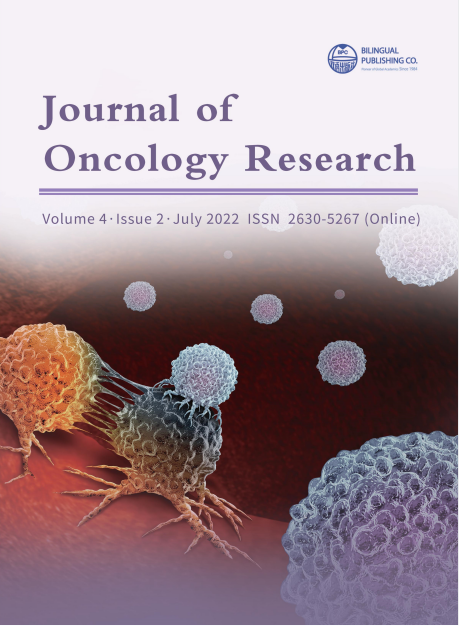Relationship between D90 and D100 with Biochemical and Local Failure in Low-risk Prostate Cancer Treated with Low-rate Brachytherapy (LDR)
DOI:
https://doi.org/10.30564/jor.v4i2.4721Abstract
Low dose rate brachytherapy (LDR) is an accepted, effective treatment with few local side effects, used as monotherapy in patients with low-risk prostate cancer (PC). The aim of this paper is to analyse 245 patients treated with LDR in the Radiation Oncology Department of the Hospital Gómez Ulla, from 2004 to 2016, evaluating the relationship of dosimetric parameters with biochemical and local recurrence as well as genitourinary and gastrointestinal toxicity derived from the technique. The results obtained show a clear relationship between the dose used and biochemical and local failure.
Keywords:
Brachytherapy; Prostate; Cancer; Dose; Failure; Biochemical; LocalReferences
[1] RTOG, 2021. RTOG Foundation. Available: https:// www.rtog.org/About-Us.
[2] Nag, S., Beyer, D., Friedland, J., et al., 1999. Recommendations for permanent transperineal brachytherapy of prostate cancer. 44(4).
[3] Rivard, M.J., Coursey, B.M., Dewerd, L.A., et al., 2004. Response to Comment on Update of AAPM Task Group No. 43 Report: A Revised AAPM Protocol for Brachytherapy Dose Calculations.
[4] Gerber, G., Thisted, R., Chodak, G., et al., 1997. Results of radical prostatectomy in men with locally advanced prostate cancer: multi-institutional pooled analysis. 32, 385-390.
[5] Pollack, A., Zagars, G., Smith, L., et al., 2000. Preliminary results of a randomized radiotherapy dose-escalation study comparing 70 Gy with 78 Gy for prostate cancer. 18, 3904-3911.
[6] Ferrer, M., Guedea, F., Suarez, J., 2013. Quality of life impact of treatments for localized prostate cancer: cohort study with a 5 year follow-up. 108, 306- 313.
[7] Ferrer, M., Suárez, J.F., Guedea, F., 2008. Health-related quality of life 2 years after treatment with radical prostatectomy, prostate brachytherapy, or externalbeam radiotherapy in patients with clinically localized prostate cancer. 72, 421-432.
[8] Prada, P., Juan, G., Gonzalez-Suarez, H., 2010. Prostate-specific antigen relapse-free survival and side-effects in 734 patients with up to 10 years of follow-up with localized prostate cancer treated by permanent iodine implants. 106, 32-36.
[9] Routman, D., Funk, R., Stish, B., et al., 2018. Permanent prostate brachytherapy monotherapy with I-125 for low and intermediate risk prostate cancer: outcome in 974 patients. Brachytherapy.
[10] Rasmusson, E., Gunnlaugson, A., Kjellen, E., et al., 2016. Low-dose rate brachytherapy in I-125 has an excellent 5-year outcome in patients with low risk prostate cancer. Acta Oncologica. 55(8), 1016-1021.
[11] Stock, R., Stone, N., Tabert, A., et al., 1998. A dose response study for I-125 prostate implants. 41, 101- 108.
[12] Nath, R., Anderson, L., Luxton, G., et al., 1995. Dosimetry of intestitial brachytherapy sources. Recommendations of the AAPM Radiation Therapy Committee Task Group No 43. 22, 209-234.
[13] Fellin, G., Mirri, M., Santoro, L., et al., 2016. Low dose rate brachytherapy as monotherapy for early stage prostate cancer in Italy: practice and outcome analysis in a series of 2237 patients from 11 institutions. 89.
[14] Martinez, E., Daidone, A., Gutierrez, C., et al., 2015. Permanent seed brachytherapy for clinically localized prostate cancer: long-term outcome in a 700 patient cohort.
[15] Roach, M., Hanks, G., Thames, H., et al., 2006. Defining biochemical failure following radiotherapy with or without hormonal therapy in men with clinically localized prostate cancer: recommendations of the RTOG-ASTRO Phoenix Consensus Conference. 65, 965-974.
[16] Chao, M., Spencer, S., Guerrieri, M., et al., 2018. A single institution analysis of low dose rate brachytherapy: 5 year reported survival and late toxicity outcomes. 10, 155-161.
[17] Prada, P., Anchuelo, J., Blanco, A., et al., 2016. Low dose rate brachytherapy for patients with transurethral resection before implantation in prostate cancer. Long-term Results. 42, 47-52.
[18] Kittel, J., Chandana, A., Kristin, L., et al., 2015. Long-term Efficacy and Toxicity of low dose rate I-125 Prostate Brachytherapy as Monotherapy in low, intermediate and high risk prostate cancer. 1-10.
[19] Zelefsky, M., Yamada, Y., Cohen, G., et al., 2007. Five-year outcome of intraoperative conformal permanent I-125 interstitial implantation for patients with clinically localized prostate cancer. 67, 65-70.
Downloads
How to Cite
Issue
Article Type
License
Copyright and Licensing
The authors shall retain the copyright of their work but allow the Publisher to publish, copy, distribute, and convey the work.
Journal of Oncology Research publishes accepted manuscripts under Creative Commons Attribution-NonCommercial 4.0 International License (CC BY-NC 4.0). Authors who submit their papers for publication by Journal of Oncology Research agree to have the CC BY-NC 4.0 license applied to their work, and that anyone is allowed to reuse the article or part of it free of charge for non-commercial use. As long as you follow the license terms and original source is properly cited, anyone may copy, redistribute the material in any medium or format, remix, transform, and build upon the material.
License Policy for Reuse of Third-Party Materials
If a manuscript submitted to the journal contains the materials which are held in copyright by a third-party, authors are responsible for obtaining permissions from the copyright holder to reuse or republish any previously published figures, illustrations, charts, tables, photographs, and text excerpts, etc. When submitting a manuscript, official written proof of permission must be provided and clearly stated in the cover letter.
The editorial office of the journal has the right to reject/retract articles that reuse third-party materials without permission.
Journal Policies on Data Sharing
We encourage authors to share articles published in our journal to other data platforms, but only if it is noted that it has been published in this journal.




 Aims and Scope
Aims and Scope Marta Dominguez Morcillo
Marta Dominguez Morcillo

